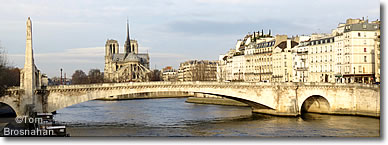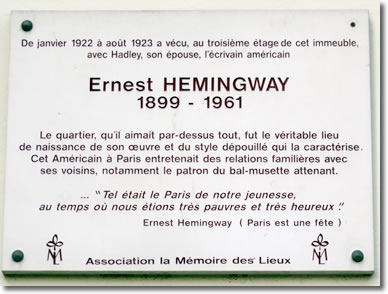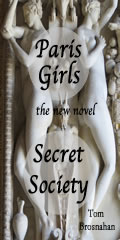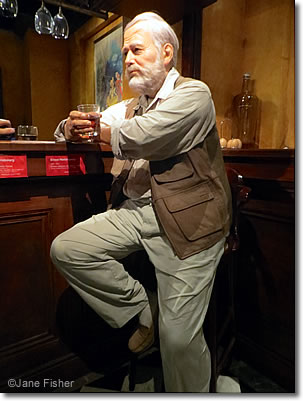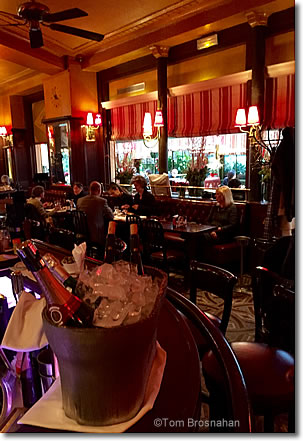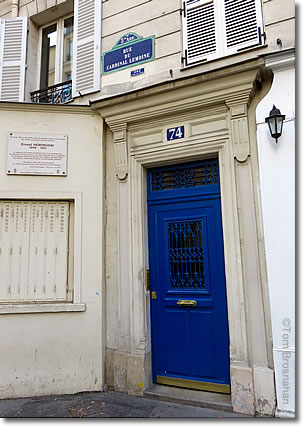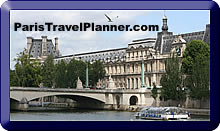 |
Hemingway in Paris - a Walking Tour | |
| It was in Paris that Ernest Hemingway developed his prose style. He wrote some of his best stories in its cafés, and returned to the city throughout his life. Here's a walking tour through the neighborhoods he knew and loved. | ||
|
Booking.com |
|
The young journalist Ernest Hemingway (1899-1961) and his bride Hadley Richardson (1891-1979) moved to Paris in 1921 and rented a 4th-floor apartment in the 5th arrondissement at 74 rue du Cardinal Lemoine, around the corner from the Place de la Contrescarpe on the hill called Montagne Sainte-Geneviève, a kilometer south of Notre-Dame (map). The city, the country, and indeed the Europe they found were recovering and rebuilding after World War I. Paris was alive with art, culture and fine cuisine, the French franc was low against the US dollar, and artists and writers from Europe and the New World flocked to its creative ferment. The Hemingways returned to Paris in January 1924 and rented an apartment at 113 rue Notre-Dame-des-Champs (map), adjacent to a sawmill and not far from Ezra Pound's studio at 70bis on the same street. Gertrude Stein and Alice B Toklas's apartment at 27 rue de Fleurus was not far away. Paris has changed greatly in the near-century since the Hemingways first arrived. Some of what they loved about the city has gone forever, but much remains, and it's still worthwhile to walk the streets they walked, visit the places they loved, and see what has survived from the Paris of the 1920s. Our Hemingway in Paris map pinpoints the top Hemingway sights in the city. Consider following the route thate Jake and Bill walked in The Sun Also Rises: The Sun Also Rises WalkJake and Bill dine at "Madame Lecomte's," a small hotel-restaurant named Le Rendez-Vous des Mariniers (long gone) on the Île Saint-Louis. They stroll the circumference of this small island, then cross the Seine on a temporary wooden footbridge built to replace the failing Pont de la Tournelle which had been demolished in 1918. The present Art Deco Pont de la Tournelle, opened in 1928, offers the same fine view of the Cathédrale de Notre-Dame de Paris as did the temporary wooden bridge.
Walk uphill on Rue du Cardinal Lemoine, now a varied street of boutiques, small art galleries, boulangerie-patisseries, offices and some nondescript modern buildings. The street narrows at the intersection with Rue Clovis, down which you catch a view of the Panthéon to the west. Just uphill from this intersection, on the left at 71 Rue du Cardinal Lemoine, is a gated private alley at the far end of which James Joyce and family lived for some months in 1921, in the apartment of translator and critic Valéry Larbaud. Two plaques recall the sojourns of these two literati. At the top of the hill, just before the Place de la Contrescarpe, on the right (west) at 74 Rue du Cardinal Lemoine, is the building in which the Hemingways had their first apartment in Paris, a 4th-floor walk-up (3rd floor French-style). A plaque marks the spot:
In the 1920s, this neighborhood was low-rent and working-class, and the cafés surrounding Place de la Contrescarpe were replete with drunkards and bums. The maligned Café des Amateurs is long gone, and today the café-restaurants surrounding the square—the book-lined Café La Contrescarpe, the busy Café des Arts, and the fine Café Delmas are popular places for breakfast, a drink, a snack, a meal, and a bit of nostalgia. On the upper floor of the building on the west side of the Place at 14 Rue Mouffetard is a sign, Au Nègre Joyeux, above a historic painting of an African valet pouring hot chocolate for a French gentilhomme. This is the only vestige remaining of one of Paris's first chocolatiers, founded in 1748. The symbolism of the historic painting is repugnant to many today, and it has been the target of stones and paint splatters. Beyond the Place de la Contrescarpe, Jake and Bill wandered through "smooth narrow streets" and old houses. Most of that neighborhood was razed and completely rebuilt in the late 1920s and 1930s with blocky government buildings of little visual interest, so you'd be better off wandering downhill along Rue Mouffetard, one of the most delightful market streets in Paris. Rue du Pot de Fer, the first street on the right (west) side off Mouffetard, is narrow, picturesque, and lined with good cafés and restaurants with indoor and outdoor seating. At the southern end of Rue Mouffetard, at Place Saint-Médard, bear right (southwest) onto Rue Édouard Quenu, which becomes Rue Broca, and follow it to Boulevard de Port-Royal. Turn right, and your next destination is La Closerie des Lilas, Hemingway's favorite café, 900 meters (1/2 mile) northwest along the boulevard, at 171 Boulevard de Montparnasse. If you're tired of walking, walk west along Boulevard de Port-Royal to the bus stop just past Rue Berthollet, board Bus 83 (Friedland-Haussmann; here's a route map, 116Kb), ride for two stops, and get out at Observatoire-Port Royal. Just west of the Port-Royal RER train station and the intersection with Boulevard Saint-Michel is the statue of Maréchal Michel Ney and, behind it, La Closerie des Lilas café-restaurant, Hemingway's favorite. The Lilas is now a fine dining restaurant with a less formal Brasserie section with the famous bar beloved by Hemingway. It's another 600 meters (1/3 mile) west along the boulevard, which here becomes the Boulevard du Montparnasse, to the Café Select, another Lost Generation favorite, now a café-restaurant called Le Select at No. 99 (another two stops on Bus 83; Métro: Vavin.) Other café-restaurants popular with the Lost Generation are still here, at the intersection of Boulevard du Montparnasse and Boulevard Raspail (map): Le Dôme at 108 Boulevard du Montparnasse, La Coupole at 102, and La Rotonde at 105.
|
|
La Closerie des Lilas Café-Restaurant, one of Hemingway's favorite places to sit and write.
74 Rue du Cardinal Lemoine, Paris 5e,
|

